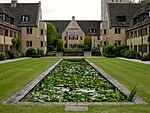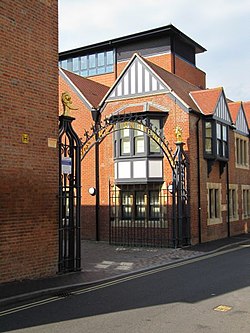Oxford Castle

Oxford Castle is a large, partly ruined medieval castle on the western side of central Oxford in Oxfordshire, England. Most of the original moated, wooden motte and bailey castle was replaced in stone in the late 12th or early 13th century and the castle played an important role in the conflict of the Anarchy. In the 14th century the military value of the castle diminished and the site became used primarily for county administration and as a prison. The surviving rectangular St George's Tower is now believed to pre-date the remainder of the castle and be a watch tower associated with the original Saxon west gate of the city. Most of the castle was destroyed in the English Civil War and by the 18th century the remaining buildings had become Oxford's local prison. A new prison complex was built on the site from 1785 onwards and expanded in 1876; this became HM Prison Oxford. The prison closed in 1996 and was redeveloped as a hotel and visitor attraction. The medieval remains of the castle including the motte, St George's Tower and crypt, are Grade I listed buildings and a Scheduled Monument.
Excerpt from the Wikipedia article Oxford Castle (License: CC BY-SA 3.0, Authors, Images).Oxford Castle
Paradise Street, Oxford City Centre
Geographical coordinates (GPS) Address Website Nearby Places Show on map
Geographical coordinates (GPS)
| Latitude | Longitude |
|---|---|
| N 51.7517 ° | E -1.2632 ° |
Address
Oxford Castle and Prison
Paradise Street
OX1 1LD Oxford, City Centre
England, United Kingdom
Open on Google Maps










